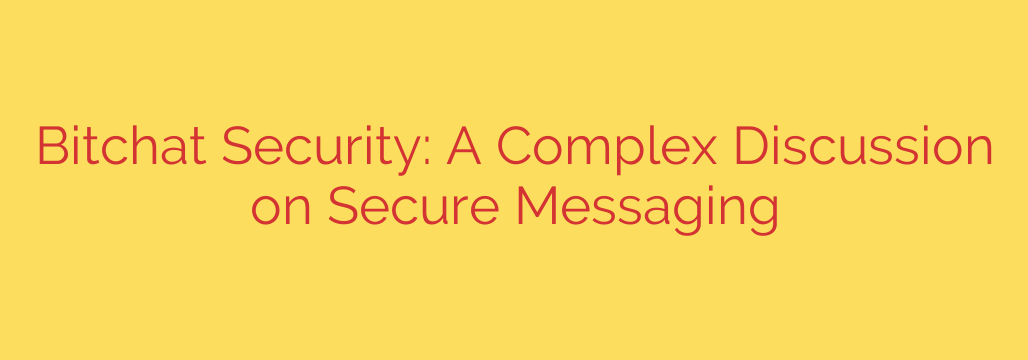
The Promise and Peril of Decentralized Messaging: A Security Analysis
In the ongoing quest for true digital privacy, many users are looking beyond mainstream apps toward a new frontier: decentralized, peer-to-peer (P2P) messaging. Platforms built on protocols like Bitchat promise a world without central servers, where communication flows directly between users, free from corporate oversight or government intrusion. But is this P2P paradise as secure as it sounds?
The reality is more complex. While decentralized messaging offers powerful advantages, it also introduces unique security challenges that every privacy-conscious user must understand.
The Core Advantage: No Central Point of Failure
The primary appeal of decentralized messaging is its architecture. Unlike traditional apps that route all messages through company-owned servers, P2P systems create a distributed network.
This design offers significant security benefits:
- Censorship Resistance: Without a central server, there is no single entity that can be pressured to shut down the service or block users. The network exists as long as its users do.
- No Central Data Honeypot: High-profile hacks often target the massive user databases held by large tech companies. In a truly decentralized system, there is no central server to hack, dramatically reducing the risk of a catastrophic data breach affecting millions of users at once.
- Built-in Encryption: Like their mainstream counterparts, these platforms rely on strong end-to-end encryption (E2EE). This ensures that only the sender and the intended recipient can read the message content.
The Hidden Dangers: Where Decentralized Security Can Falter
Despite these strengths, the promise of perfect privacy can be misleading. The very nature of a distributed network creates vulnerabilities that are often overlooked.
1. The Metadata Problem is Magnified
End-to-end encryption is excellent for protecting the content of your messages, but it does nothing to hide the metadata. Metadata is the data about your data—who you’re talking to, when you’re talking, how often, and from what IP address.
In a P2P network, nodes must broadcast information to find each other and deliver messages. This activity can be monitored. Sophisticated adversaries can analyze network traffic to map out social connections and patterns of communication, even without reading a single word of your encrypted messages. For journalists, activists, or anyone requiring true anonymity, this metadata leakage is a critical security risk.
2. The Challenge of Key Verification
Secure communication relies on ensuring you are talking to the right person. This is handled through public key cryptography. However, you must have a trusted way to verify that a public key truly belongs to your contact. If you don’t, you could fall victim to a Man-in-the-Middle (MITM) attack, where an attacker secretly intercepts and relays messages, posing as your contact.
Mainstream apps often simplify this with QR codes or safety numbers. In many decentralized systems, this process is less user-friendly, placing the burden of verification squarely on the user. Failing to perform this “out-of-band” verification (e.g., confirming a key fingerprint over a phone call or in person) can completely undermine the platform’s security.
3. Network-Level Attacks
Decentralized networks are also susceptible to specific forms of attack. A “Sybil attack,” for instance, involves a malicious actor creating a large number of fake identities (nodes) to gain a disproportionate influence over the network. This could be used to disrupt message delivery, monitor traffic, or deanonymize users. Protecting a public, open network from this type of manipulation is an ongoing and complex computer science problem.
Actionable Tips for Using P2P Messengers Safely
Decentralized messaging can be a powerful tool for privacy, but it requires diligence. It is not a “set it and forget it” solution.
- Always Verify Your Contacts: Never trust a public key at face value. Use a separate, trusted channel (a phone call, video chat, or in-person meeting) to verify the key fingerprint with your contact before sharing sensitive information.
- Obscure Your IP Address: To combat metadata analysis, always use a decentralized messenger in conjunction with a trusted VPN (Virtual Private Network) or Tor. This helps hide your real IP address, making it much harder for anyone to link your network activity back to you.
- Understand the Protocol’s Limitations: Not all P2P messengers are created equal. Research the specific platform you intend to use. Does it have known vulnerabilities? How does it handle metadata? Is the project actively maintained by developers?
- Practice Strong Operational Security (OpSec): Your communication is only as secure as the device you use. Keep your operating system and apps updated, use strong, unique passwords, and be wary of phishing attempts designed to compromise your device and steal your private keys.
Ultimately, decentralized messaging represents an exciting and important evolution in private communication. It offers a robust alternative to centralized, corporate-controlled platforms. However, users must approach it with a clear understanding of its trade-offs. True security comes not from the tool alone, but from using it wisely and cautiously.
Source: https://blog.trailofbits.com/2025/07/18/building-secure-messaging-is-hard-a-nuanced-take-on-the-bitchat-security-debate/








